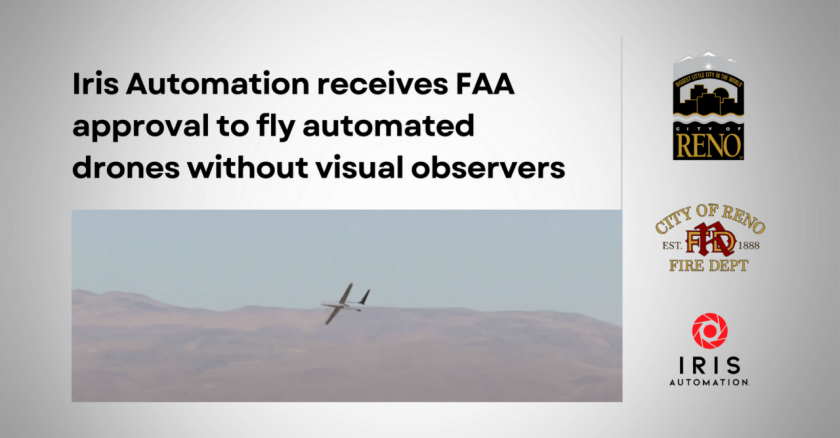The Federal Aviation Administration (FAA) has given approval to fly a small drone autonomously beyond the pilot’s line of sight (BVLOS), without any visual observers or the use of additional ground-based detection equipment in a rural, unpopulated area south of Reno. This waiver is an important step in achieving autonomous flight, first testing over unpopulated areas before it can move to urban areas, according to a joint press release.
Iris Automation, on behalf of the City of Reno and the Reno Fire Department (RFD), received the FAA approval based on its detect and avoid solution, Casia X, which provides enhanced situational awareness.
Each year the RFD conducts approximately 41 Water Entry Team (WET) rescues with 85% of them occurring on the Truckee River. Approximately 10% of these calls occur in the dark with many requiring first responders to enter the water. The average response mission lasts about an hour and includes approximately 12-20 first responders. Water exposure, especially in moving water incidents, is extremely dangerous for victims and first responders.
Using UAS in a beyond visual line of sight (BVLOS) capacity will have a significant, positive impact on saving lives and reducing the resources required for these operations, putting fewer fire department personnel at risk. This goal continues the efforts the City established during the final phases of the FAA UAS Integration Pilot Program.
Reno is a participant in the FAA BEYOND program, designed to assist the FAA in establishing safety and performance standards for BVLOS operation by working with a diverse array of industry and public stakeholders. It provides extensive real-world, operational learning in the field to help inform regulatory recommendations. The City and Iris Automation have collaborated since 2019, first in the FAA’s Integration Pilot Program (IPP) and now in the BEYOND program, to test the use of autonomous drones during river rescue missions.
“This is an exciting project, working with the BEYOND program and the latest technologies to open the skies both for our community and the broader public,” Reno Mayor Hillary Schieve said. “It’s a unique teaming of public and private interests to achieve breakthrough operations for a wide range of cost-effective, public-facing services. Autonomous flying will benefit every member of our community and drive long term economic benefits including job creation, cost savings and more efficient services. We intend this to be our first of many waivers as part of this collaboration. We’re proud to be leading the way in this incredible space—and with a local BEYOND participant too—and excited to see our partners moving to this next step in the process.”
Casia X uses Iris Automation’s patented detect and avoid technology to detect, alert and avoid non-cooperative aircraft. For operators to fly autonomously over distances, onboard sensors like Casia X, combined with carefully designed concepts of operation provide a cost-effective and scalable solution, enabling high levels of safety, according to Iris Automation.
For more information visit:
www.irisonboard.com




